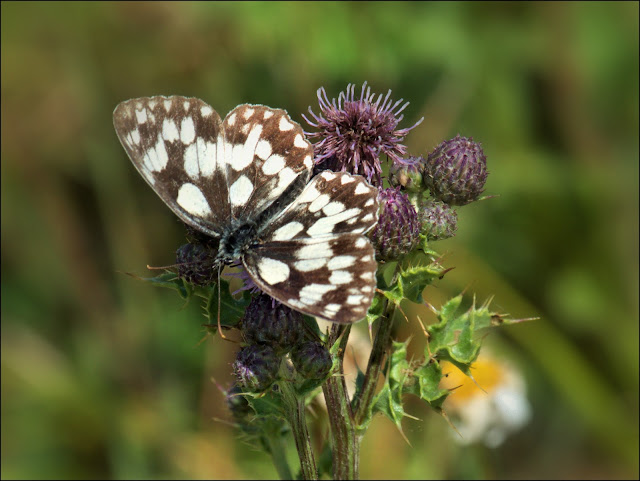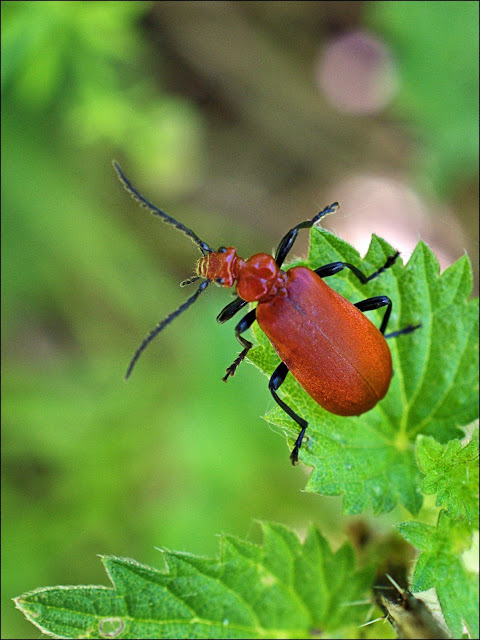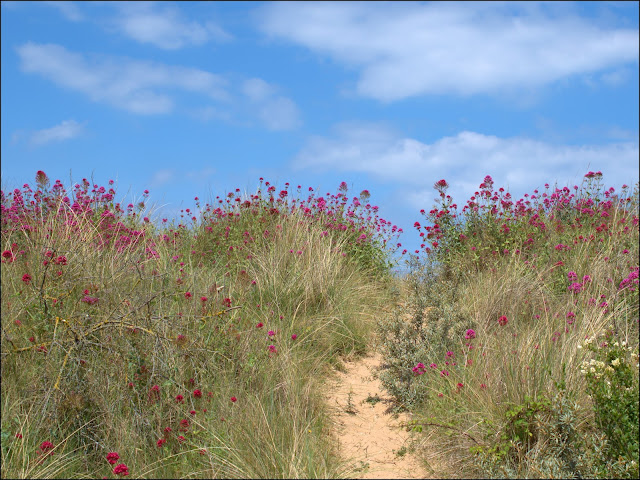My walk ended up on familiar, well-trodden paths - though there's always something different to see and photograph. The title has rather given the game away: a flock of raggle-taggle sheep are grazing Shepreth Moor and there's a magnificent tangle of weeds on the poppy field. So with no further ado.....
Pages
Sunday, 26 June 2022
Sheep And Weeds
Thursday, 23 June 2022
A Three-Thousand Horse Town
In England it's often difficult to decide whether a site should be classified as of historic importance, scientific interest, recreational value or natural beauty. In such a small country things tend to get mixed up - and in this particular case you can also throw a couple of works of art and one of the country's top sporting venues into the mix.
As you approach the small Suffolk town of Newmarket (human population 15,000) this mighty statue literally rears up ahead of you. It's called the Newmarket Stallion and it stands right in the middle of the road on a traffic island and announces to everyone that this is the horse-racing capital of the UK.
We're about to walk right through the middle of the racetrack, or more exactly we're walking between the July Course and the Rowley Mile Course. Yes, there's more than one course here at racing HQ. In fact the whole town is surrounded by everything to do with the Sport of Kings. There was no actual racing today but we saw one or two horses being exercised as we began our walk and we'll have a look for some more later this morning.
Our walk is along the top of this raised bank, giving us views out over the race courses and the surrounding countryside. This embankment looks like the kind of thing that might have once carried a railway; it's on that sort of scale - though in fact it's much, much older. There's a deep trench along the west side and the whole thing's called Devil's Dyke.
It's around seven miles (11.3 Km) in length and about 30 feet (10 metres) from the bottom of the ditch to the top of the bank. But as you walk along it becomes clear that neither figures nor photos can express the enormous effort of building such a thing. It was probably dug around the fifth or sixth century AD by Anglo-Saxons, though it's not clear whether it was to prevent an invasion, to control trade along the ancient Icknield Way or perhaps even for reasons of prestige. There's an old legend of course....
A big wedding was being held in Reach, at the northern end of the Dyke. The Devil was not invited, but decided to go anyway. He was refused entry and left for home, at high speed and in high dudgeon. His fiery tail left a deep scorch-mark across the fields, which was ever after known as Devil's Dyke. Maybe there's a grain of truth in this tale.....did two tribes unite, perhaps through marriage?...perhaps another tribe felt threatened by this new alliance and dug this defensive ditch as protection...perhaps, perhaps. One thing is clear though: the Devil, rather than dwelling in the depths of hell, once resided in the sleepy Suffolk village of Wood Ditton - that's where the Dyke ends!
The chalky, sun-facing slopes form a rich haven for wildlife, notably chalk-loving plants and the insects associated with them. Marbled White butterflies were everywhere (though the two photos here were taken elsewhere, in much trickier conditions, the day before and, having gone to so much trouble, I'm not going to waste them!).
Butterflies seem to come into this world with a not-very-clear idea of what they can feed on and they dither about from flower to flower, like some absent-minded shopper, until by chance they stumble upon the right one. You want to grab them by the antennae and say "This is what you're looking for!", but all you can do is stand by, patiently or impatiently, camera in hand, and wait.
It's called a Lizard Orchid because it's said that the individual flowers resemble small lizards. You can, sort of, see the head and the tail and maybe some little short legs.
Or can you? Whatever you might think about their likeness to lizards, they are certainly some very strange flowers. And they smell of goats.
And here they stand, right beside the race track. They are quite common plants in parts of mainland Europe, but here they are confined to a few places with chalky soils.
Having found our orchids there was time to quickly visit the training gallops alongside the Moulton road to see some of the thoroughbreds being put through their paces. They gallop up one way...
Of course, this is Newmarket, so even the Queen has to share the plinth with a racehorse and its foal.
Sunday, 19 June 2022
It's The Little Things
Children have a different view of the world from grown-ups. They have little use for grand views or beautiful countryside, but have a seemingly inbuilt obsession with messy corners inhabited by creepy-crawlies and squirmy-wormies - life on a smaller and more manageable scale. The kind of thing which adults usually don't even notice. Somehow I've managed to retain some of my childish inquisitiveness; so here are a few insects and wild flowers that have entertained me recently.
Small Tortoiseshell Butterfly
One of our more familiar garden butterflies which everyone sees at least a few times every summer. But how many of us notice the jewel-like blue crescents along the edges of the wings? They can be very territorial and will chase any other butterflies that encroach on what they consider to be their bit of the flowerbed. According to the Wildlife Trusts' website the males "court" the females "by drumming their antennae on the females hindwings". Now that's something to look out for.
I mentioned these in a recent post, so I thought I'd better find some for you. I also mentioned how wild orchids sometimes appear in unlikely places and these are a case in point, growing on a small patch of grass in a street in the modern village of Bar Hill. The flowers are supposed to mimic bees and thus attract real bees in to pollinate them. It must work as Bee Orchids are not that rare.
Despite the name Scarce Chasers are not that scarce - not around the many old flooded gravel pits around here anyway. That's the female in the picture above.
This tiny flower is a specialist of chalky soils and, while it can turn up in specially managed hay-meadows, it's just as likely to be found in abandoned quarries or, as here, on a heap of waste soil left over from excavating a small farm reservoir. Yellow Wort is actually a member of the Gentian family, but one that is very easily overlooked.
From the same heap of soil as the Yellow Wort, comes this Pyramidal Orchid. There are also Bee Orchids, Common Spotted Orchids and vast numbers of Ox-Eye Daisies on the same site. Pyramidal Orchids have occasional moments of nationwide fame when they get on the News for appearing in thousands on a particular traffic roundabout.
It's amazing how such a handsome little chap can be so little known. The Red-Headed Cardinal Beetle is a fairly common insect of gardens, parks and hedgerows.
The Broomrapes are a very odd group of flowers which lack any green leaves. Instead of photosynthesising they rely on gaining their nutrients from the roots of other plants, in this case Lady's Bedstraw. This particular example was found growing on sand dunes on the North Norfolk Coast. The host plant, Lady's Bedstraw, is a fairly unspectacular yellow flower which gets its name from the fact that it was once used for stuffing hay mattresses, to which it gave a pleasant scent.
Friday, 17 June 2022
A Day In Sunny Hunny
Every year, at about this time, the people of land-locked Cambridgeshire are seized by a sudden urge to visit the coast. Hunstanton is the nearest and most obvious place to go. From early forays with buckets and spades, to teenage adventures sleeping in beach huts, to later excursions taking elderly parents out for the day, right through to recent visits in search of shorebirds and seabirds - most of them came up for discussion during the course of a recent visit with my brother to "Sunny Hunny", as Hunstanton is less formally known.



















































